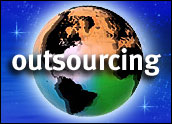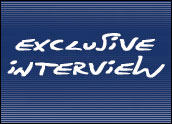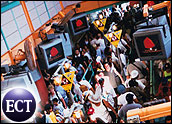
Mark Wesker, president and CEO of Artifact Network, has been involved in the software industry for nearly 15 years. The co-founder, president and COO of Sequoia Software in 1992, he stayed on after Citrix Systems acquired the company in 2001. With a year as vice president of Internet strategy under his belt, Wesker left Citrix to co-found Artifact in Baltimore.
In an era of prevalent outsourcing — some of it hurriedly agreed to without due diligence — Artifact aims through its Scorecard service to help small and mid-sized businesses determine the right outsourcing vendor for their needs.
Its on-demand software product, Lighthouse, is designed to help small and mid-sized businesses track productivity and emerging problems in their outsourced arrangements. Marketplace, a client-acquisition tool, allows outsourcing vendors to open up their processes through the bidirectional Lighthouse product.
Outsourcing’s New Direction
Wesker talked exclusively with CRM Buyer about his company’s role in the outsourcing of software development.
CRM Buyer: What has happened with outsourcing to inspire your business model?
Mark Wesker: I think the state of the industry is high-growth right now. Offshore outsourcing of software development is moving from very large organizations to small and mid-sized organizations, micromultinational companies. There are three primary reasons for this:
One is cost and the ability to reduce the costs associated with software development. Cost is always a primary driver for innovation, and it certainly is expensive to develop software in the United States now.
Two is time to market. After the dot-com bust, kids stopped going to school for software engineering. The time it takes here to build good teams and train software developers is five to six months. Offshore outsourcers have ready-to-go teams of people able to ramp up almost overnight.
Three is core competency — and what isn’t. For example, Artifact is a software company. It produces software for customers, but its core competency isn’t writing code. Most people look at the cost and time to market and decide that they should outsource the writing of code. There are a lot of vendors offering software development, but to decide to just jump in is the primary reason for failure.
CRM: How prevalent is disciplined global outsourcing monitoring?
Wesker: It is absolutely not prevalent. Most companies continue to use Microsoft Word and Excel and homegrown stuff. Most haven’t spent money to monitor and measure. Our biggest competitors aren’t other on-demand software providers, but [companies using] the old ways.
All of the challenges of offshore outsourcing can be overcome. People know more about software programs than they ever did before. When they build software in-house, they are able to make corrective decisions along the way. When they run into problems, things just change.
In an outsourcing arrangement, companies have to be able to identify when change is necessary, manage the change and closely monitor the process. They have to take responsibility for projects. And as globalization really becomes the dominant force in our economic system, it’s the small and mid-sized businesses that have not had affordable monitoring systems to grow and succeed. Large companies have been doing it for a while.
Outsourcing is a proven and successful business model, but it does require people to do things differently. That’s where we find the most challenge. Problems rear their ugly heads when U.S. companies don’t adapt themselves to a different business model.
CRM: How does a product like Lighthouse help U.S. companies manage an outsourcing engagement as it progresses?
Wesker: Small and mid-sized companies ask why large companies succeed. They failed at first, like with anything new. But all ultimately built internal processes to make this cheaper and quicker solution work — to be effective in outsourcing.
That’s what Artifact did. It looked at systems that provide data, visibility, control and predictability to track, monitor and measure outsourcing engagements. Really, what we’re doing at Artifact is commoditizing the infrastructure and systems that large companies have built themselves, and making it available to the mass market. They can have tools to make sure things don’t go wrong.
Problems are exacerbated when you take projects global. It increases the likelihood that problems will be more severe. Lighthouse is an early warning system. The dashboards give more than 200 companies real-time data, and outsourcers tell me that their most successful projects are with highly participatory clients.
Software has developed a reputation for taking too long, costing too much and not being delivered as planned. If you have real-time visibility of your efforts, you get much closer to your goals.
CRM: Why is a service like Scorecard needed?
Wesker: Small and mid-sized companies can’t outsource the same way they’ve been doing it and expect it to work. The failures are not related to countries or cultures in which outsourced work is managed but in U.S. companies not understanding.
Due diligence is hard to do, but through Scorecard, outsourcing service providers give data on past projects and then new data comes from Lighthouse users. Having to measure yourself is great inspiration to do well. And if they’re not willing to be measured, they’re not helping us as an industry.





















































